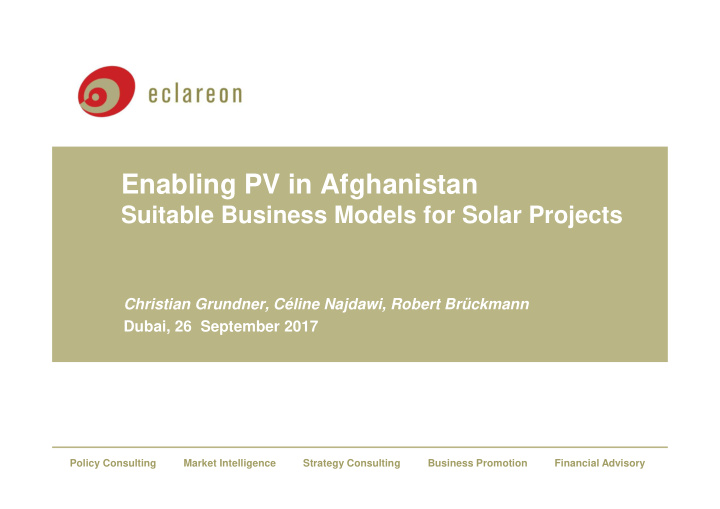



Enabling PV in Afghanistan Suitable Business Models for Solar Projects Christian Grundner, Céline Najdawi, Robert Brückmann Dubai, 26 September 2017 Policy Consulting Market Intelligence Strategy Consulting Business Promotion Financial Advisory
Agenda • Profitability of Business models for PV in Afghanistan 1. Off-grid project: - 400 kW PV-Diesel hybrid plant with battery support 2. Rooftop Net-Metering project: - 100 kW commercial plant in an urban area 3. PPA project: - 5 MW ground-mounted PV plant connected to the grid • Conclusions AGENDA 2
Off-grid projects 3
PROFITABILITY OFF-GRID Project Overview: PV-Diesel hybrid project with battery in an off-grid location with a PPA tariff and investment subsidy. 4
PROFITABILITY OFF-GRID Equity Cash Flow: Payback of equity investment is achieved after 6 years only, due to the high investment subsidy. 5
PROFITABILITY OFF-GRID Project Cash Flows: Revenues increase due to the inflation adjustment of the PPA price. High interest debt can be avoided due to the subsidy. 6
SENSITIVITY OFF-GRID Based on the exemplary assumptions, the favourable irradiation allows for profitable off-grid PV projects in all Afghan regions. 7
SENSITIVITY OFF-GRID Reduction of customs tariff is another effective option to reduce system prizes and significantly increase the profitability of a project. 8
SENSITIVITY OFF-GRID The PPA price is comparable to large residential on grid consumers. However, for remote off-grid consumers this price may be even lower. 9
Rooftop projects 10
PROFITABILITY NET-METERING Project Overview: Commercial net-metering project on a roof-top in an urban area with less solar irradiation compared to the PPA example. 11
PROFITABILITY NET-METERING Equity Cash Flow: Payback is achieved already in year 5 due to high commercial electricity prices and the remuneration for excess electricity. 12
PROFITABILITY NET-METERING Project Cash Flows: Funding is based on equity only. Revenues increase over time due to adjustments of electricity prices in accordance with inflation rate. 13
SENSITIVITY NET-METERING Another key factor for the profitability is if and by how much excess PV electricity is being remunerated by the net-metering scheme. 60% self-consumption 80% self-consumption 100% self-consumption 14
Large scale PPA 15
PROFITABILITY PPA 5 MW Project Overview: Grid connected small to medium-sized ground- mounted system in a location with high solar irradiation. 16
PROFITABILITY PPA Equity Cash Flow: Payback of equity investment is achieved in year 9 only due to ongoing debt service in the first 15 years. 17
PROFITABILITY PPA Project Cash Flows: Revenues slightly increase over time due to the a 2% inflation adjustment of the USD based PPA price. 18
SENSITIVITY PPA The customs tariff for PV components is a key lever for the government to reduce turnkey prices and support PV. 19
SENSITIVITY PPA Only an interest rate that is significantly below the applied debt interest rate of 13,5% would have a stronger leverage effect on the equity IRR. 20
SENSITIVITY PPA Assuming high confidence in the PPA off taker, the USD based PPA price generates feasible returns for foreign investors. 21
Conclusions • Currently, the profitability of PV projects in Afghanistan can only partially be analysed on the basis of real figures, either because projects are lacking (e.g. rooftop PV), or because existing projects are donor-based. • Due to the currently high interest rates in Afghanistan mainly donor-based projects or projects with predominant equity financing are financially viable. • The government can heavily influence the profitability of PV systems by focussing on the reduction of systems prices and particularly custom duties for PV systems. • For net-metering projects, the profitability also depends on the adjustment of electricity prices. AGENDA 22
Policy Consulting Market Intelligence Strategy Consulting Business Promotion Financial Advisory
Recommend
More recommend